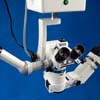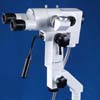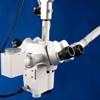The Slit Lamp Microscope: Parts And Function
Ophthalmologists and optometrists use the slit lamp microscope to look at a magnified view of the eye in order for them to diagnose possible eye disease or refractive errors. A slit lamp microscope is an ophthalmic instrument that uses a high-intensity light that can be focused through a narrow slit to illuminate the object being viewed under the eyepiece, in this case, the patient’s eyes. This kind of biomicroscope provides a three-dimensional or stereoscopic view of the patient’s eyes through a binocular eyepiece. The magnification of the objectives can be adjusted using the dial located at the side of the ocular. Surgical or operating slit lamp microscopes are also equipped with a zoom function that can be operated with foot pedals so that the hands of the ophthalmologist or eye surgeon would be left free to continue with the operation.The slit-lamp that is used for illumination is mounted on a base that can be adjusted so that the ophthalmologist can focus the light on different aspects of the eye while doing the examination. The light coming from the narrow slit can be changed according to thickness and height using the levers located on the pivoting base. For example, the ophthalmologist would need to adjust the light to a broad beam and place it at full height and low brightness to look at the surface of the eye, which can be done using a joystick. This kind of ophthalmic examination is done under diffuse illumination. A thinner and brighter light beam on full height, on the other hand, is used for a cross-sectional view of the eye, which is useful for viewing the anterior segment of the eye as well as the cornea and is called direct focal illumination.
Sometimes, alien matter like minute fragments of metal get caught up in the eye and cause surface abrasions. The use of the ophthalmic eye surgery microscope is important in this application. For the ophthalmologist to be able to locate and take these fragments away, as well as locate abrasions for treatment, a fluorescein dye is used to help them distinguish between the pats of the eye better. This is done by placing the dye on the eyes using an eyedropper or a stained piece of paper that would be touched against the side of the patient’s eyes. The ophthalmologist would then use a cobalt blue or green filter with the illumination to see the fluoresced parts of the eye through the operating microscope.
On another hand, dilating drops might be used to view the posterior or back segment of the eyes. this works by dilating the cornea of the eye to allow the ophthalmologist to view the posterior segment accordingly. Some patients may experience adverse effects after the application of these drops. It would be best if they contact their eye care specialist immediately if they experience pain in the eyes or nausea after the eye examination.
Attached in front of the slit lamp biomicroscope is a stage where the patient can rest their chin and forehead to ensure minimal movement while the ocular examination is taking place. This positioning frame is made up of metal rods attached to a chin rest and a forehead strap. Too much movement in the part of the patient might lead to erroneous readings, so the patient would be advised to move as little as possible while the ophthalmologist is looking at the magnified view of their eyes.
Under the base of the slit-lamp are switches that can be used to turn the biological microscope on and off and adjust light intensity. The lever can be used to adjust the elevation of the biomicroscope while a locking screw that could be found at the base can be used to secure the slit lamp microscope from moving.
Providing a magnified and even a cross-sectional view of the eye, the slit lamp microscope is an important ophthalmic instrument for both ophthalmologists and eye surgeons not only for examining the eye for disorders but also for performing actual ophthalmic surgery. Measuring corneal thickness, for example, has only been done manually in the past. This was before the slit lamp illumination made a cross-section view of the eye possible. The slit lamp biomicroscope is also used with a gonioscope in order to view an iridocorneal angle or the angle that is made between the iris and the cornea. This view is especially useful in monitoring and managing eye diseases that may result from glaucoma. Another ophthalmic instrument, called the tonometer might also be attached to the slit lamp biomicroscope to measure the patient’s intraocular pressure (IOP), which is an indicator of a person’s risk for developing glaucoma. Accordingly, regular ocular or eye examinations using the slit lamp microscope would assure the patient of a thorough inspection of their vision and eye health.
Back to Articles
call toll-free:  or email
or email

 or email
or email
Categories
Categories
Dental
Dental Microscopes
Dental Microscopes
Ophthalmic
Ophthalmic Microscopes
Ophthalmic Microscopes
Gynecology
Gynecology Colposcopes
Gynecology Colposcopes




